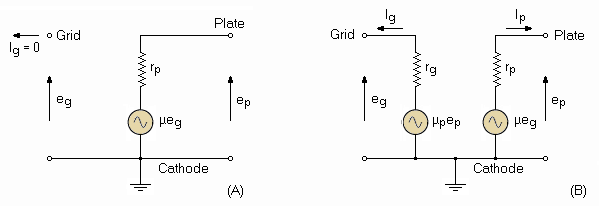| Transistor Basics is a free introductory textbook on transistors and their basic applications. See the editorial for more information.... |

|

Home  The Grounded Base Transistor The Grounded Base Transistor  Vacuum-Tube Analysis Vacuum-Tube Analysis |
||






|
||
|
Vacuum-Tube Analysis on a Four-Terminal BasisAuthor: Leonard Krugman
Fig. 3-2. Equivalent circuit of a triode: (A) with negative grid bias, (B) with positive grid bias.
μeg = iprp + ep The four-pole equivalent network for this same circuit when the grid draws current is illustrated by Fig. 2 (B). In this case, the grid voltage acts across a series circuit consisting of the voltage μpep and the grid resistance rg. The term μp equals the reverse voltage amplification factor: μp = eg/ep. As in the previous case, the grid signal voltage causes a voltage μeg to appear in series with the plate resistance. Since there are two voltage loops in the case when the grid is driven positive, two equations are required to describe the network completely; these are μee = iprp + ep eg = igrg + μpep This analysis of triode vacuum tubes on a four-pole basis is not limited to the grounded-cathode operation of these tubes. The choice of this type of operation is dictated on the basis of reader familiarity with the circuit. The grounded-grid and grounded-plate connections (which have useful counterparts in transistor circuitry) may be analyzed in similar fashion. The basic four-terminal current-voltage relationships for all three cases are illustrated in Fig. 3-3.
Fig. 3-3. Four-terminal network ground connection: (A) cathode, (B) grid, (C) plate.
|
||
Home  The Grounded Base Transistor The Grounded Base Transistor  Vacuum-Tube Analysis Vacuum-Tube Analysis |
||
Last Update: 2010-11-17



